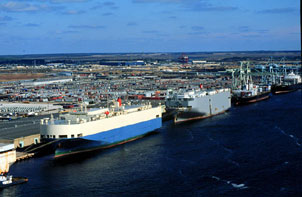Downloadable Statistics (pdf) | Definitions Pertaining to Statistics
 AAPA continuously receives requests on how ports rank nationally and internationally. The question is ambiguous, however, since ports can be compared in many different ways – by volume or value of trade, number of cruise passengers, revenues, and storage capacity, as examples.
AAPA continuously receives requests on how ports rank nationally and internationally. The question is ambiguous, however, since ports can be compared in many different ways – by volume or value of trade, number of cruise passengers, revenues, and storage capacity, as examples.
Moreover, sheer size of a port, in terms of traffic flow, says nothing about productivity, efficiency, or responsiveness to customers. These are just some of the criteria that a shipper might consider in evaluating port performance.
The American port industry plays a critical role in driving the nation’s economy, generating jobs, facilitating trade, and supporting communities across the United States. As we look to the future, understanding the true scope and impact of our ports is more important than ever.
Our latest Economic Contribution Report reveals just how significant this industry is, with U.S. ports contributing nearly $2.59 trillion to the national GDP and supporting 1 in every 8 American jobs. This report not only highlights the tremendous growth in port operations over the past decades but also provides a detailed look at the vital role ports play in ensuring the stability and success of the U.S. economy.
Explore the full report to dive into key findings, data, and insights that demonstrate the powerful contribution of America’s ports.
Download the 2024 Economic Contribution Report
Download the 2024 Economic Contribution Technical Analysis
Download the topline infographic
2024
2023
2022
2020
2019
2018
2017
2016
2015
2014
2013
2012
2011
2010
2009
2008
2007
Definitions Pertaining to Statistics
TEU = “Twenty-Foot Equivalent Unit,” a standard linear measurement used in quantifying container traffic flows. As examples, one twenty-foot long container equals one TEU while one forty-foot container equals two TEUs (i.e., 40'÷ 20' = 2).
TONS = A short (or “net’) ton = 2,000 pounds
A long ton = 2,240 pounds
A metric ton = 2,205 pounds
|
CONVERSION TABLE |
||
|
TO CONVERT |
INTO |
MULTIPLY |
|
Long Tons |
Short Tons |
1.12 |
|
Long Tons |
Metric Tons |
1.016 |
|
Metric Tons |
Long Tons |
0.9844 |
|
Metric Tons |
Short Tons |
1.1025 |
|
Short Tons |
Metric Tons |
0.907029 |
|
Short Tons |
Long Tons |
0.89287 |
VESSEL SERVICE:
Liner = cargo carried in vessels according to a fixed scheduled of routes and port calls. Most containerized, as well as some breakbulk cargo, falls in this category.
Tramp = Dry cargo carried on chartered vessels. Includes mainly dry bulks such as coal, grain, and fertilizers, as well as steel and, in some cases, autos.
Tanker = Bulk liquid cargo, such as crude oil, carried on tanker vessels.